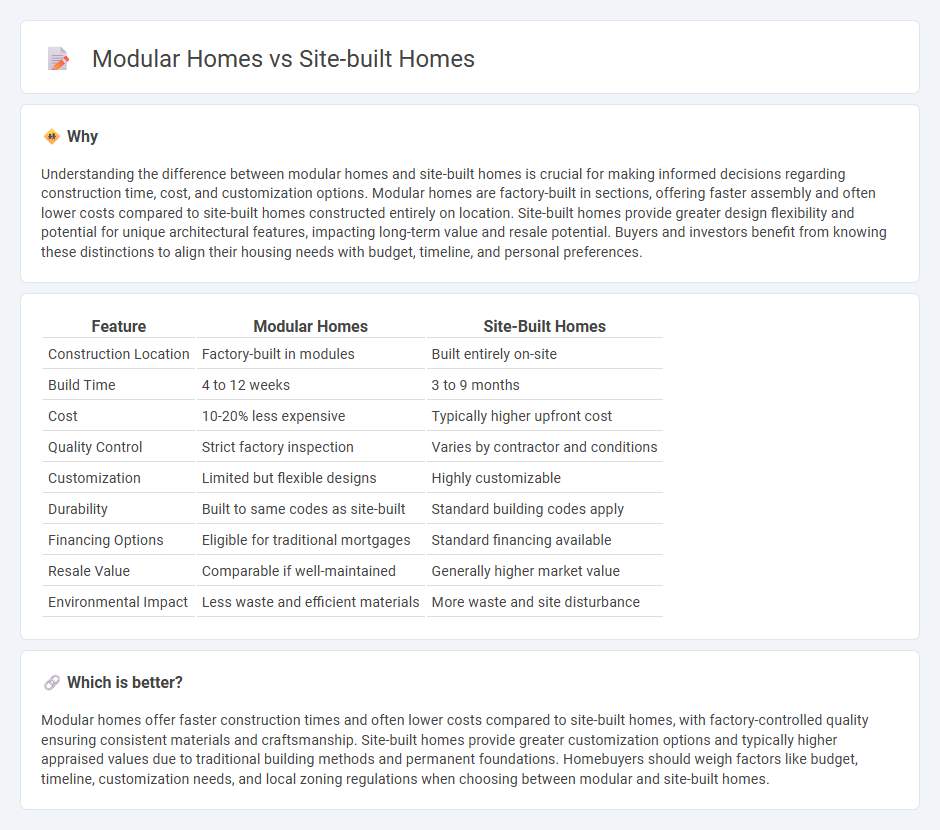
Modular homes offer faster construction times and consistent factory-built quality compared to traditional site-built homes, which allow for more customization and unique architectural designs. Energy efficiency and cost savings are often superior in modular homes due to controlled building conditions, while site-built homes provide flexibility in location and design adjustments during construction. Explore the key differences in investment value, durability, and customization options to determine which home type best suits your needs.
Why it is important
Understanding the difference between modular homes and site-built homes is crucial for making informed decisions regarding construction time, cost, and customization options. Modular homes are factory-built in sections, offering faster assembly and often lower costs compared to site-built homes constructed entirely on location. Site-built homes provide greater design flexibility and potential for unique architectural features, impacting long-term value and resale potential. Buyers and investors benefit from knowing these distinctions to align their housing needs with budget, timeline, and personal preferences.
Comparison Table
| Feature | Modular Homes | Site-Built Homes |
|---|---|---|
| Construction Location | Factory-built in modules | Built entirely on-site |
| Build Time | 4 to 12 weeks | 3 to 9 months |
| Cost | 10-20% less expensive | Typically higher upfront cost |
| Quality Control | Strict factory inspection | Varies by contractor and conditions |
| Customization | Limited but flexible designs | Highly customizable |
| Durability | Built to same codes as site-built | Standard building codes apply |
| Financing Options | Eligible for traditional mortgages | Standard financing available |
| Resale Value | Comparable if well-maintained | Generally higher market value |
| Environmental Impact | Less waste and efficient materials | More waste and site disturbance |
Which is better?
Modular homes offer faster construction times and often lower costs compared to site-built homes, with factory-controlled quality ensuring consistent materials and craftsmanship. Site-built homes provide greater customization options and typically higher appraised values due to traditional building methods and permanent foundations. Homebuyers should weigh factors like budget, timeline, customization needs, and local zoning regulations when choosing between modular and site-built homes.
Connection
Modular homes and site-built homes are connected through their use of traditional construction materials and adherence to local building codes, ensuring comparable quality and durability. Both methods allow for customization in design and layout, meeting diverse homeowner needs and preferences. The primary distinction lies in modular homes being prefabricated in controlled factory settings before assembly on-site, while site-built homes are constructed entirely at the location.
Key Terms
Construction Method
Site-built homes are constructed entirely on the building site, allowing for customization and flexibility in design, often resulting in longer construction timelines. Modular homes are fabricated in controlled factory environments using standardized sections, enabling faster construction with consistent quality and fewer weather delays. Explore detailed comparisons of site-built and modular home construction methods to determine the best fit for your project needs.
Building Codes
Site-built homes must adhere strictly to local building codes throughout construction, ensuring compliance with zoning, safety, and environmental standards specific to the location. Modular homes are constructed in controlled factory settings following the same building codes and standards as site-built homes, but their prefabrication process often results in faster inspections and quality control. Explore the detailed differences in building code compliance between site-built and modular homes to make an informed decision.
On-site Assembly
On-site assembly of site-built homes involves constructing the entire structure from the ground up at the location, allowing for greater customization and flexibility but often resulting in longer build times. Modular homes are prefabricated in sections within a factory setting and transported to the site for quick assembly, significantly reducing construction time and minimizing weather-related delays. Explore the benefits and considerations of on-site assembly for both home types to determine the best fit for your building project.
Source and External Links
Site-built homes: What you need to know - Site-built homes are constructed from raw materials directly on the buyer's chosen land, offering extensive customization options such as floor plans and home size, and must comply with local building codes and zoning laws.
Comparison of the Costs of Manufactured and Site-Built Housing - Site-built homes generally cost more than manufactured or modular homes, with construction costs being significantly higher, though they include land, foundations, and site preparation in total cost calculations.
Prefab Homes - Prefab homes are built in a factory and transported to the site for assembly, making them more affordable and quicker to assemble compared to site-built homes, which require full construction on-site.
 dowidth.com
dowidth.com